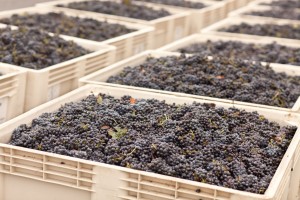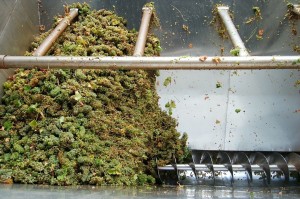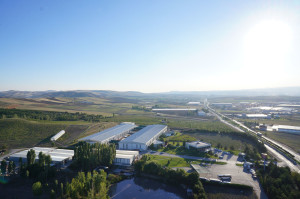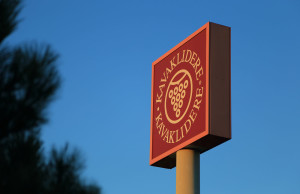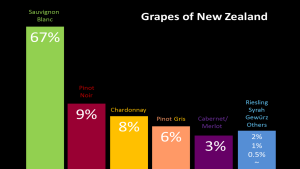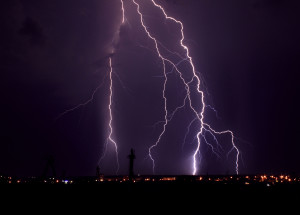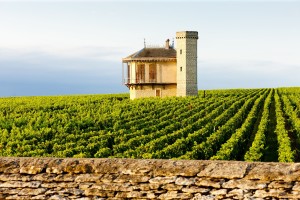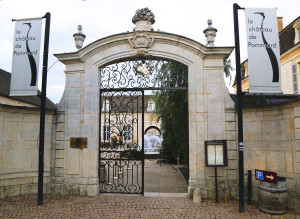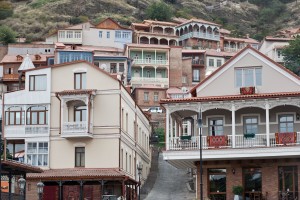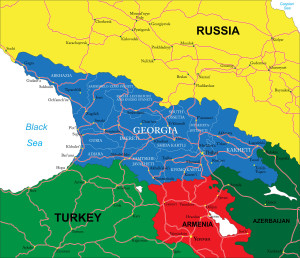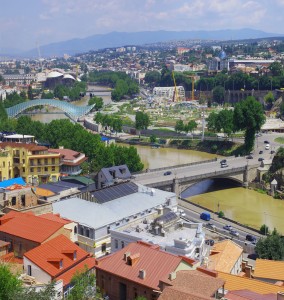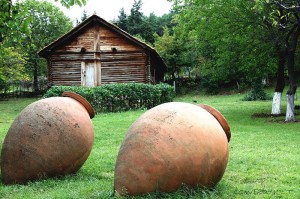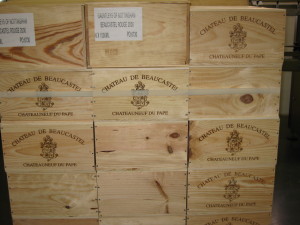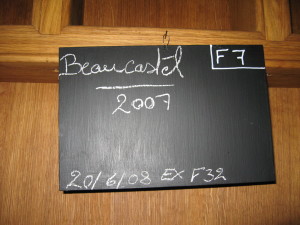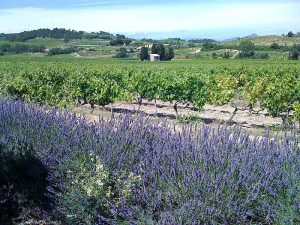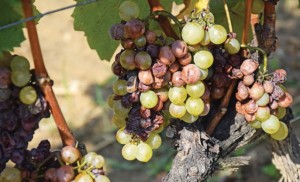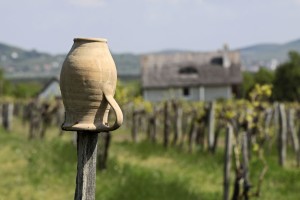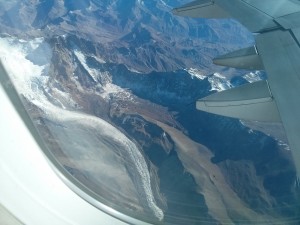
Photo credit: Justin Gilman
Today we have a guest post from Justin Gilman, CSW who went on the wine-travel “bucket list” trip of a lifetime to Mendoza, Argentina. Read on to hear about this high-altitude wine region, from the ground up!
I traveled to Mendoza on April 13th as a guest of the “Familia Zuccardi” family winery. I had been introduced to this family winery years ago, carried numerous labels and all along the way, discovered more about their quality wines. I’ve attended the “Mendoza Masters” seminars in Denver led by winemaker Sebastain Zuccardi and importer Winesellers LTD. I was excited and anxious to meet the family, become familiar with Mendoza, and experience these great wines at the source.
The trip began in Denver, and onto Miami. An 8-hour long flight down to Santiago, Chile was the grunt of the trip. All along I had anticipated the notable flight over the Andes Mountains. Anyone who has made wine their carrier knows about the Andes and the important role they play to Argentina wine. As simple as it sounds, you don’t realize just how real the mountains are until you experience it for yourself.
Our plane landed in Santiago around 7am. The sun wasn’t up yet, and it was pitch black outside the window. The pilot announced he would land with autopilot because of the dense fog prohibiting any sort of vision to the runway. Shortly after we landed, standing at the gate, the sun came out and exposed a marine layer of which we couldn’t see 50 feet outside the airport window. This had caused our connecting flight to be slightly delayed to Mendoza.
The flight over the Andes brought a new perspective on time and distance. Literally climbing, then diving down over the mountains on a 45 min flight. The Andes below were vast. Mountain tops sharp and jagged at the highest points. Winds blow the peaks clean and the wind chill easily froze any existing moisture the weather provided. You can easily see where glaciers melt and the runoff slowly descends down the mountain. Small lakes form in craters and some parts of the mountain looked smooth from the distance – most likely shaped by extreme winds over time.

Photo credit: Justin Gilman
On the Eastern side of the mountains descending, we didn’t see ocean fog, but cumulous nimbus clouds contoured into every nook of the mountain. This was a picturesque definition of “Rain Shadow”. The Andes are measured at 310 miles wide at its farthest points and 4,300 miles long. The average height is 4,000 feet. This mountain range is longer than the U.S. is wide (excluding Hawaii and Alaska). Cumulus clouds max out at around 3,300 feet. These clouds never cross over these massive peaks. This experience has allowed me to completely understand the effect of the Cascade Mountains in Washington and the role they play to that wine region as well. Living in Denver, I’m used to flying over the Rockies going to and from the West Coast. Somehow, the jagged peaks of the Andes seemed much more dominant.
The “Santa Julia Winery” in Maipu was our first stop. This is the family’s large production facility that has sustainable and organically farmed grapes. The Zuccardi family is one of the largest producers in Argentina, meanwhile keeping a humble, small family mentality. They are 2nd in sparkling wine production, making both charmat and traditional method styles. The honesty and transparency to their wines, along with commitment to sustainability and organics were quickly displayed. Producing entry-level wines with native yeasts and labeling wines honorably with their family name was refreshing. The location has two “farm to table” restaurants on site, “Casa Visatante” and “Pan & Oliva”, both catering different styles of culinary genius. They produce olive oil and have a spirit still for brandy. They are well under way with Solera aging for their Port style wines.
The Santa Rosa Vineyard is among the family’s largest acreage. It has been in the family and helped the Zuccardi’s learn and become who they are today. The family knows where they’ve been, where they are, and clearly has a vision for the future. The Santa Rosa Vineyard dedicates 1 hectare to numerous plantings of experimental or as they say “Innovacion” grapes. Nero D’Avola, Albarino and even Mersalan (a cross between Cabernet Sauvignon/Grenache) are planted, along with many more. Each year, the two best are bottled and sold in the tasting room. These grapes are monitored and progress is considered for the Valle de Uco vineyards.
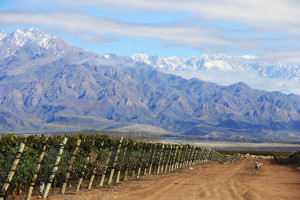
Photo via http://www.zuccardiwines.com/145/Fotos/
The Maipu winery has clearly been the anchor for the family since the 1960’s with each new generation benefiting from the last. It’s reaching production capacity and the family is aligning its future behind the addition of the new Valle de Uco winery set for completion in September 2015.
The week progressed like the perfect storyline. Starting with family history and their bulk facility on the first day, then escalated to the new winery and top tiers over night. I had seen, tasted and carried these quality wines, but visiting the new winery on this day was mind blowing. In my 15 years in the industry, I’ve never witnessed such attention to detail and commitment to terroir on such a large scale.
The next day we drove almost an hour to the “Altamira Vineyard” site. The elevation for this vineyard area is 3,412-3,772 feet. Uco Valley is one of the world’s highest wine growing regions, with over 80,000 hectares planted between 3,000-3,900 feet and plenty of sunlight.
We started the day with the winery geologist “Martin”, and it was clear that his mission first and foremost was to explain in detail, the terroir of the Uco Valley, as well as introducing us to the philosophy going forward. Martin had aerial terrain maps and technology graphs to explain why the vineyard was planted the way it was. Blocks and rows were planted after using electric mapping in the soil to determine soil density, help determine erosion and gather more info as to which varietals were best suited on particular blocks. Blue colors were less dense with red being extremely dense.
The highlight of this visit was his explanation of alluvial rocks scattered throughout the vineyard. Glaciers melt atop of the Andes and the runoff carries down the soil and nutrients to the valley floor. The point at the base of the mountain, in which the soil spreads out is known as an “alluvial fan” or “alluvial zone”. Topographical maps clearly show green, thriving soil and moisture at the end of these zones and much less moisture at the beginning of these patterns.
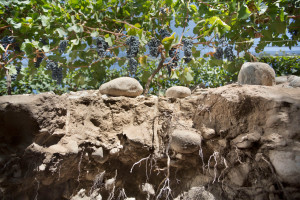
Photo via: http://www.zuccardiwines.com/145/Fotos/
Martin took us into the vineyard and removed alluvial rocks from holes dug within 50yds of one another. He mentioned roughly 400 holes had been dug over a few years’ time to completely understand what was taking place along the surface of the vineyard block. Explaining that there was a film of calcium deposit on the rocks, he rubbed his palm on a medium size rock and clearly the white coating from the rock transferred to his palm, leaving a bare spot on the rock. He then asked for participants to do the same and lick our palms. We did. The taste was clearly salty. He had explained to us earlier that this was a reaction to elements in the soil and limestone coating the rock. Calcium deposits in water drift to the bottom of the ocean through pressure. Over time, the layers of deposits consolidate and create a hard mass. He explained that the fossilized rocks in his office were proof that rocks traveling down from the top of the Andes to the valley floor were evidence that the top of the Andes Mountains were once underwater. These are the things you hear, but of course have a stronger realization when you’re there looking at fossils.
After the vineyard tour we were lead to the new winery building. It has been in use for two years, though still under construction. In fact its first harvest began without the roof on the building. The new winery is made from the same rocks scraped from under the foundation. Binding clay and sediment soils from the nearby Rio Negro River used with alluvial rocks to make the walls of the building. No two walls are the same. It was explained that from a distance, the profile of the winery roof blends into the Andes Mountain behind it and that the path from the front door will mimic the “alluvial fan” of the mountain base. It will not be landscaped, but left to develop with the terroir. Weeds, erosion, grass and flowers will occur naturally.
We ventured into this amazing structure. Plans were discussed for an open kitchen with a concrete oven, and a huge 6ft rock they discovered while digging into the plans for a 10,000-bottle wine cellar would remain in place. Concrete eggs a long time ago were decided to be the fermenters of choice. More stable fermentation temps and the fact that stainless steel fermenters discharge a slight electric current influencing the wine just were two reasons behind the change. State of the art made with what nature has given, we were all astounded.
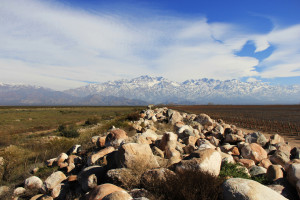
Photo via: http://www.zuccardiwines.com/145/Fotos/
We tasted four different samples of 2014 Malbecs. Samples were chosen to display extreme differences in terroir. From soft and grapey in clay soil, to minerally/chalky in alluvial rock. The Altamira showing a slight ‘forest floor’ and moist dirt on the nose and in the glass, similar to Oregon Pinot Noir, but with Malbec. One of the samples came from the “Gualtallary Vineyard”. Very much a point of focus in the future, this region seems to be up and coming and on their radar. Located Southwest of Tupungato, Gualtallary is even higher elevation of 3,937-4,921 feet and different soil compositions of course, meaning extreme “terroir-ists” can remain excited about possibilities for time to come. We sampled both 2014 and 2015 wines displaying these extreme differences in terroir.
Sebastian and his family are passionate about terroir, and determined enough to break the mold stylistically of what we see every day with Malbec, Torrontés and Cabernet Sauvignon coming from Argentina. The mass exodus of Malbec over the years to America seems to have thinned out quality and damaged Argentina’s reputation in some circumstances. This trip was truly insightful and has given me an extreme appreciation of terroir and diversity of varietals grown in Argentina, not to mention seeing the potential first hand. The family has tremendous integrity and dedication to organic practice. I look forward to returning to the new winery after its completion and possibly visiting other wineries both big and small, to help further my knowledge of this region that is much, much more than just Malbec.
Justin Gilman, CSW is the Store Manager/Buyer for Jordan Wine & Spirits, a leading retailer in Parker, Colorado, located in Denver’s South Metro area. With over 15 years in alcohol beverage retail, in the major markets of Orange Co., and Los Angeles California, he now resides in Denver Colorado, where his skill set as an operator and buyer are utilized for both retail and as a consultant in the industry.
For more information on the Familia Zuccardi and their wines, visit their website here.
 Today we have a Conference Preview from Tim Gaiser, MS about test anxiety – something Tim has witnessed first hand many times over his long and much-lauded career as a wine educator. Read on for information on Tim’s upcoming conference session!
Today we have a Conference Preview from Tim Gaiser, MS about test anxiety – something Tim has witnessed first hand many times over his long and much-lauded career as a wine educator. Read on for information on Tim’s upcoming conference session!  Tim Gaiser is an internationally renowned wine expert and lecturer. He is one of 175 individuals worldwide to ever attain the elite Master Sommelier wine title. Over his 25-plus year career Tim has taught thousands of students in wines and spirits classes at every level as well as developing wine education programs for restaurants, winery schools and wine distributors. He has experience in all phases of the wine industry – online, wholesale, retail, winery, and restaurant – including stints at Heitz Wine Cellars in the Napa Valley and Bix and Cypress Club restaurants in San Francisco, and Virtual Vineyards/the original wine.com. His client list includes Fosters Global Wines, Diageo, American Express, Evian, Pepsico International, Fiduciary Trust, Franklin-Templeton, Morgan Stanley, and Wells Fargo.
Tim Gaiser is an internationally renowned wine expert and lecturer. He is one of 175 individuals worldwide to ever attain the elite Master Sommelier wine title. Over his 25-plus year career Tim has taught thousands of students in wines and spirits classes at every level as well as developing wine education programs for restaurants, winery schools and wine distributors. He has experience in all phases of the wine industry – online, wholesale, retail, winery, and restaurant – including stints at Heitz Wine Cellars in the Napa Valley and Bix and Cypress Club restaurants in San Francisco, and Virtual Vineyards/the original wine.com. His client list includes Fosters Global Wines, Diageo, American Express, Evian, Pepsico International, Fiduciary Trust, Franklin-Templeton, Morgan Stanley, and Wells Fargo. 